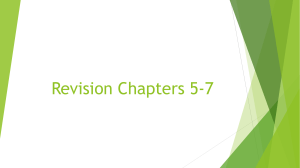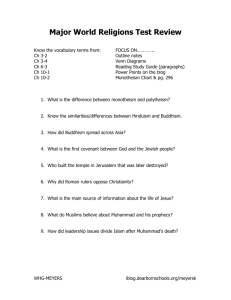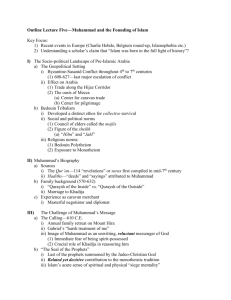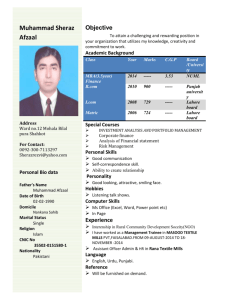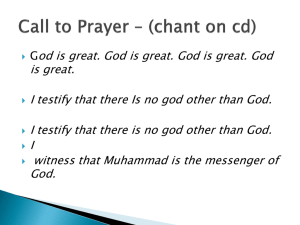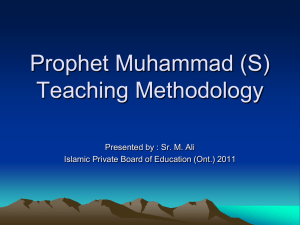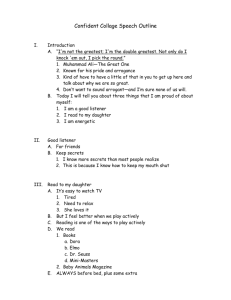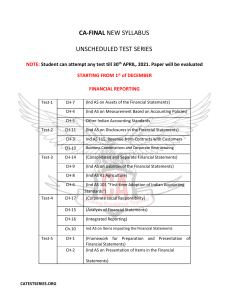Course Outline - UMT Admin Panel
advertisement
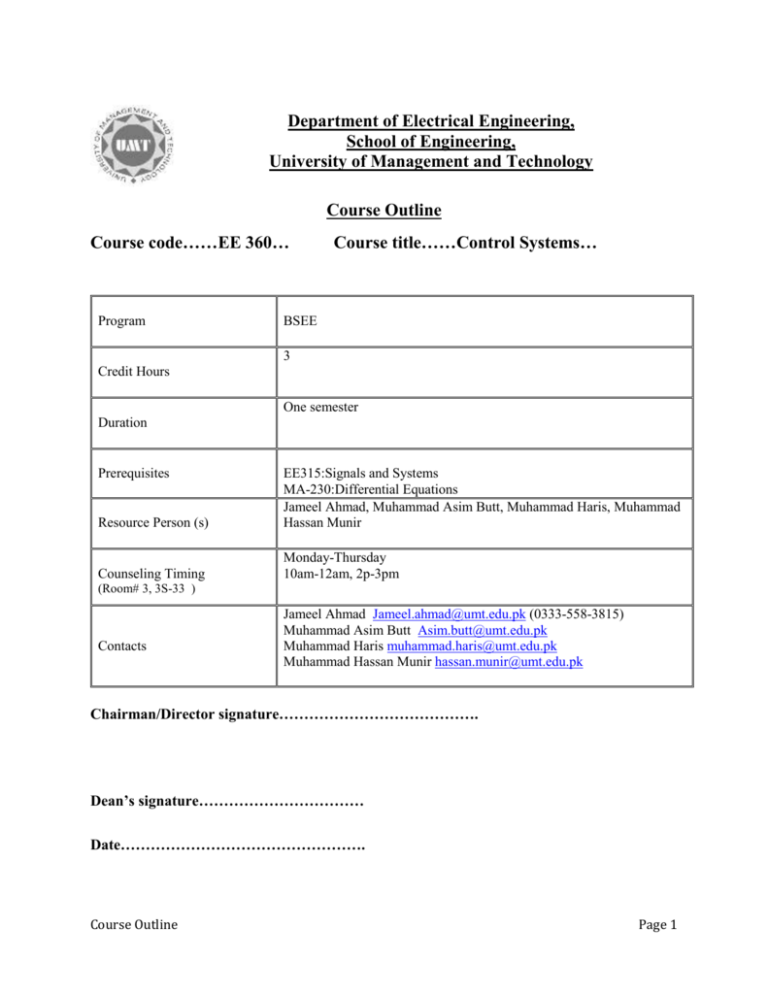
Department of Electrical Engineering, School of Engineering, University of Management and Technology Course Outline Course code……EE 360… Program Course title……Control Systems… BSEE 3 Credit Hours One semester Duration Prerequisites Resource Person (s) EE315:Signals and Systems MA-230:Differential Equations Jameel Ahmad, Muhammad Asim Butt, Muhammad Haris, Muhammad Hassan Munir Counseling Timing Monday-Thursday 10am-12am, 2p-3pm (Room# 3, 3S-33 ) Contacts Jameel Ahmad Jameel.ahmad@umt.edu.pk (0333-558-3815) Muhammad Asim Butt Asim.butt@umt.edu.pk Muhammad Haris muhammad.haris@umt.edu.pk Muhammad Hassan Munir hassan.munir@umt.edu.pk Chairman/Director signature…………………………………. Dean’s signature…………………………… Date…………………………………………. Course Outline Page 1 Learning Objectives: The course deals with the analysis and design of linear control systems. This course is meant to provide basic training and familiarity with feedback control systems. Feedback systems are ubiquitous in daily life and appear in many other disciplines including communications, industrial process control, aerospace systems, vehicle engine systems, environmental efficiency, and elsewhere. Classical control methods of analysis and design are used for linear systems and provide intuitive procedures for feedback control based on systems structure. State Variable methods since 1960s have been responsible for the high performance and stability of modern engineered systems including aerospace, robotic, and industry processes. Specific Course objectives are as follows: To provide students with basic background in Linear Feedback Control Systems analysis and design. To lay the foundations of classical control design including root locus, Bode plots, stability and system properties. To understand tools for system analysis including differential equations, transfer functions, and state variable methods. To provide an introduction to basic analysis and design methods in state variable systems. To train students in the use of MATLAB/SIMULINK for system design and simulation for the workplace. The lab sections will give students an understanding of implementing these concepts on actual physical processes including DC motor Speed Control, Magnetic Levitation, Ball and Beam system, Inverted Pendulum, Servo mechanisms. Student Learning Outcomes: 1. Acquire the mathematical tools needed to analyze feedback control systems by classical methods including root locus, Bode, and Routh Test. 2. Understand the basic concepts of state variable analysis 3. Ability to perform designs with various control tools using MATLAB computer simulation toolboxes. 4. Ability to perform design of feedback control systems using classical methods. 5. Ability to perform feedback control system design using state variable form including pole placement. 6. Understand the implementation of feedback control systems methods on actual industrial processes. 7. Learn to work in teams and contribute as a member to a group project Learning Methodology: Lecture, interactive, participative, Computer Simulations Grade Evaluation Criteria Following is the criteria for the distribution of marks to evaluate final grade in a semester. Course Outline Page 2 Marks Evaluation Marks in percentage Quizzes 15 Assignments 10 Mid Term 25 Attendance & Class Participation NA Term Project NA Presentations NA Final exam Total 50 100 Recommended Text Books: 1. Modern Control Engineering (5th Edition) by Katsuhiko Ogata (Sep 4, 2009) Reference Books: 1. Control Systems Engineering by Norman S. Nise (Dec 14, 2010) 2. Modern Control Systems (12th Edition) by Richard C. Dorf and Robert H. Bishop (Jul 29, 2010) 3. State Variables for Engineers by Paul M. DeRusso, Rob J. Roy, Charles M. Close and Alan A. Desrochers (Dec 1997) 4. Control System Design: An Introduction to State-Space ,Bernard Friedland (Mar 24, 2005) 5. Analog and Digital Control System Design: Transfer-Function, State-Space, and Algebraic Methods by Chi-Tsong Chen (Jan 1, 1993) Calendar of Course contents to be covered during semester Course code………………EE360….... Course title……Control Systems……………… Lectures Course Contents Reference Chapter(s) Course Outline Page 3 1-2 3-4 5-6 7-8 9-10 11-12 13-14 Control Systems: An introduction Closed-loop vs. Open Loop Control Laplace Transform Theorems Partial Fraction Expansion Solving Linear Time-invariant Differential Equations Ch-1 and Ch2 Mathematical Modeling of Dynamic Systems Transfer function and Impulse response function Modeling of Mechanical Systems: Mass-Spring-Damper system Modeling of Electrical Systems: RLC Circuits/DC motor/Op-Amp circuits Cascade, Parallel and Feedback closed-loop systems, Signal Flow Graphs Classification of Industrial Controllers (ON-OFF,P,PD,PI,PID) Ch-3 Proportional, Integral and Derivative Control Actions PID Control Closed Loop System Subjected to Disturbance Modeling Electrical/Mechanical Systems in State Space State Space Representation of Dynamic Systems Transformation from Transfer function to state-space and vice-versa Ch-3 Transient and Steady State Response of Dynamic systems Unit-step, unit-ramp and unit-impulse response of First Order and 2nd-order systems DC-Motor performance Ch-5 Under-damped, over-damped and critically damped 2nd order systems Transient response specifications Servo Mechanisms: Armature-controlled DC Servo Motor Stability analysis in the complex plane Routh Stability Criterion Ch-5 Integral and derivative control actions and system performance Steady-state errors in unity-feedback control systems Higher order systems and dominant closed-loop poles Examples of Electro-mechanical Systems Operational-Amplifier circuits used as Controllers/Compensators Linearization of Non-linear Systems Magnetic Levitation Ball-and-Beam Ch-5 Notes Mid Term Examination 15-16 Ziegler–Nichols tuning rule for PID Control 17-18-19 20-21 Control system analysis using Root Locus Method Plotting Root Locus Control System design using Root-Locus approach Lead Compensation using Root Locus Lag Compensation using Root Locus Course Outline Ch-8/Ch-6 Ch-6 Page 4 22-23 Control System Design using Frequency Response Method Bode Diagrams Phase Margins and Gain Margins Polar Plots, Nyquist Stability Criterion, Lead Compensation using Frequency Response Method Lag Compensation using Frequency Response Method Ch-7 24-25 Design Examples on Lead/Lag compensators Ch-6/Ch-7 28-29 Control Systems in State-Space State space representation of Transfer functions Controllable and Observable canonical forms Ch-9 30-31 Solving the Time-invariant State-Equation; Laplace Transform approach State Transition Matrix and its properties Cayley–Hamilton Theorem (if time permits) Controllability and Observability (if time permits) Ch-9 Ch-7 26-27 32 Final Exam Course Outline Page 5
